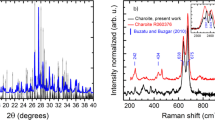Abstract
The thermal reactivity of the naturally occurring silicates jadeite, NaAl[Si2O6], and nephrite, a variety of actinolite, Ca2 (Mg,Fe)5[(OH,F)Si4O11]2, have been investigated by thermogravimetric and thermomechanical analysis as well as temperature-dependent X-ray diffraction and analytical electron microscopy. TG shows that nephrite undergoes a weight loss at around 900°C. Mass spectrometry reveals that this irreversible reaction corresponds to the evolution of H2O, and XRD shows that a phase related to diopside CaMg[Si2O6] is formed. Jadeite does not undergo and observable weight changes up to 1000°C. Thermomechanical analysis indicates a reversible phase transition at about 950°C. Temperature-dependent X-ray diffraction shows that jadeite is again present on cooling (peak temperature: 1000°C), but that this is accompared by an additional unidentified phase. The mechanism of this process is not yet clear although it has been observed in several samples from different origins and with different metal impurities.
Zusammenfassung
Mittels thermogravimetrischen und thermomechanischen Methoden sowie mit Hilfe von temperaturabhängiger Röntgendiffraktion und analytischer Elektronenmikroskopie wurde die thermische Reaktivität der in der Natur vorkommenden Silikate Jadeit NaAl[Si2O6] und Nephrit, einer Abart von Aktinolith Ca2(Mg,Fe)5[(OH,F)Si4O11]2 untersucht.
Laut TG zeigt Nephrit einen Gewichtsverlust bei etwa 900°C. Die Massenspektrometrie besagt, daß diese irreversible Reaktion mit der Freisetzung von H2O verbunden ist und die Röntgendiffraktion zeigt, daß dabei eine Phase Diopsid CaMg[Si2O6] gebildet wird. Jadeit zeigt bis 1000C keinerlei beobachtbaren Gewichtsverluste. Die thermomechanische Analyze zeigt eine reversible Phasenumwandlung bei etwa 950°C. Die temperaturabhängige Röntgendiffraktion zeigt, daß Jadeit beim Kühlen wieder anwesend ist (Peaktemperatur: 1000°C), daß dies jedoch von einer zusätzlichen, nicht identifizierten Phase begleitet wird. Der Mechanismus dieses Prozesses wurde noch nicht vollständig geklärt, obwohl er an zahlreichen Proben verschiedenen Ursprunges und mit verschiedenen metallischen Verunreinigungen beobachtet wurde.
Similar content being viewed by others
References
H. Strunz, Mineralogische Tabellen, Akad. Verlagsgesellschaft Geest & Portig, 8th edition, Leipzig 1982.
H. J. Rössler, Lehrbuch der Mineralogie, VEB, 2nd edition, Leipzig 1981.
Jade, R. Keverne, Consultant Editor, Van Nostrand Reinhold, New York 1991.
F. Ward, Nat. Geogr., 172 (1987) 282.
H. G. Wiedemann and G. Bayer, Thermochim. Acta, 200 (1992) 215.
Author information
Authors and Affiliations
Rights and permissions
About this article
Cite this article
Reller, A., Wilde, P.M. & Wiedemann, H.G. Thermal reactivity of jadeite and nephrite. Journal of Thermal Analysis 40, 99–105 (1993). https://doi.org/10.1007/BF02546559
Published:
Issue Date:
DOI: https://doi.org/10.1007/BF02546559



